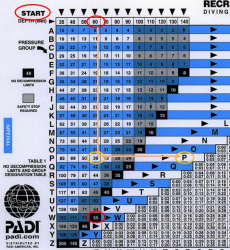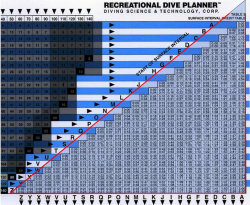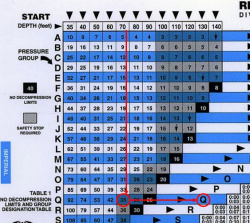Divetalking » The Recreational Dive Planner – Instructions for use – PADI
The Recreational Dive Planner – Instructions for use – PADI
CAUTION: Do not attempt to use the Recreational Dive Planner without first reading the Instructions for use. The Recreational Dive Planner is intended for use by certified divers or those under the supervision of a certified scuba instructor. Misuse of the Recreational Dive Planner may result with serious injury or death. Consult the instruction manual or a certified scuba instructor prior to its use. If you have any questions regarding its use, please reach out to a certified scuba instructor.
Because everyone is physically and physiologically different, no table can guarantee that their susceptibility to Decompression Illness will never occur when diving within table limits.
Plan on having at hand the Diving Science and Technology Recreational Dive Planner sanctioned by PADI, a Pen/pencil, and paper. If you do not have an RDP, you may click on the depictions below to expand their size.
If this is the first time you will be walking through the RDP, plan on spending about an hour for the exercises below. You may always return to this page to continue your studies of course if your time is limited.
I encourage you to walk through all the exercises. Practice makes perfect and the more you practice, the easier it becomes.
Contents
Section One
Using the Recreational Dive Planner Table
General Rules for the use of the Recreational Dive Planner
Special considerations and rules for Repetitive Dive
Section Two
Identifying the minimum Surface Interval
Section One
Using the Recreation Dive Planner Table
The following article will be using the Diving Science and Technology Recreational Dive Planner.
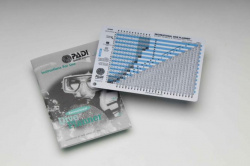
If you need a Diving Science and Technology Recreational Dive Planner and Study booklet, you may purchase one by clicking on PURCHASE.
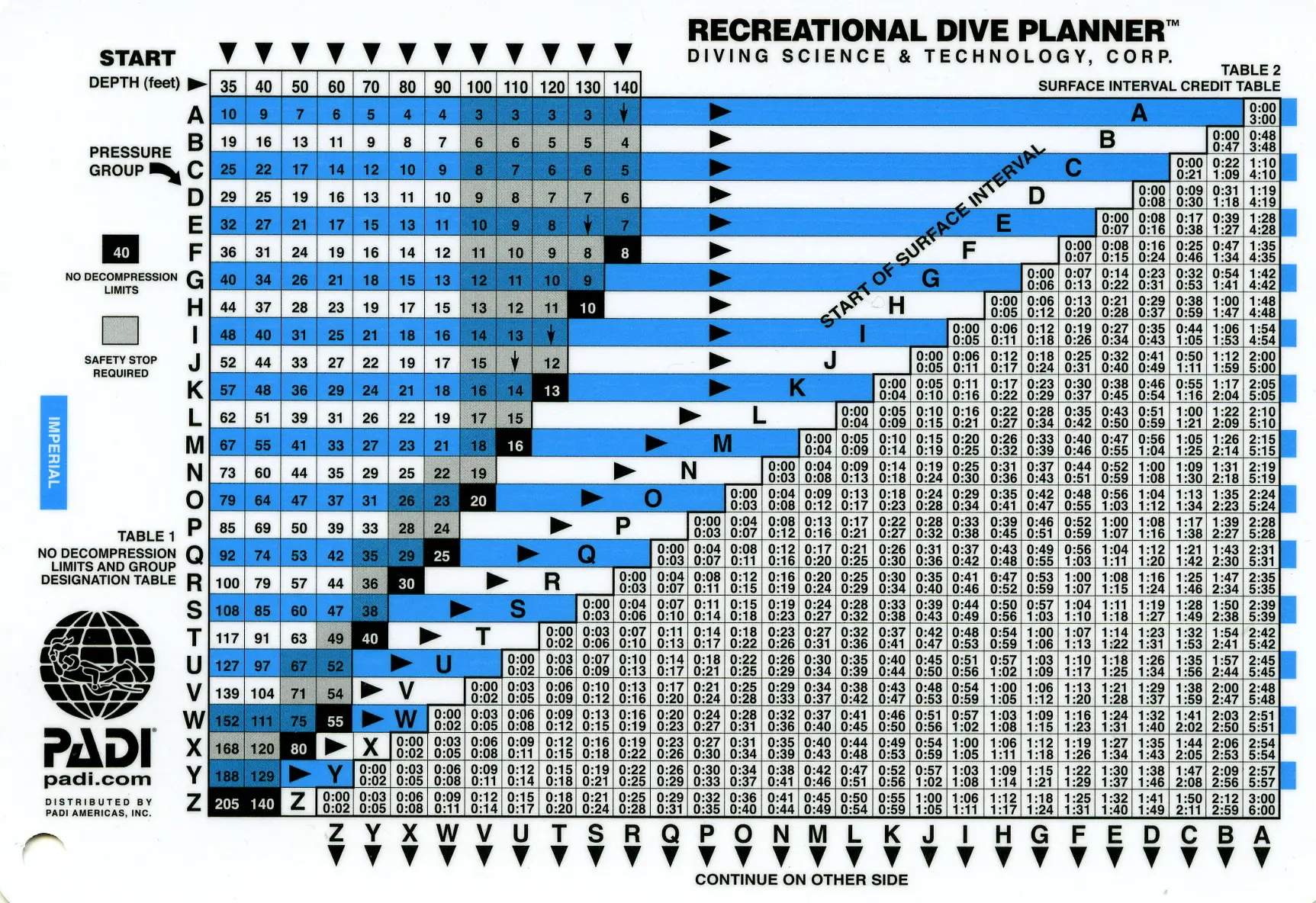
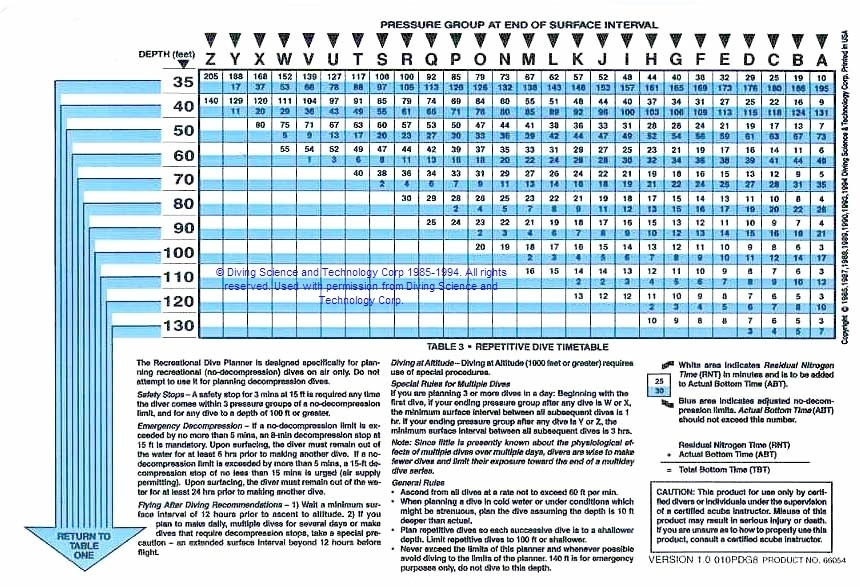
The purpose of the recreational dive planner is to calculate for no decompression dives. For the benefit of those just learning to dive, decompression is a term used to describe an act for removing excess nitrogen accumulated in the body during the course of a dive, prior to reaching the surface. It usually means pausing the ascent at a specific depth for a specific amount of time before resuming the ascent. Decompression may occur in stages, like steps of a staircase, where with each step up the staircase there is a pause in the ascent to allow excess accumulated nitrogen time to be released from the body. The definition defined for recreational diving implies a diver never reaches the state of decompression and may reach the surface without the obligation to pause the ascent to release excess accumulated nitrogen. The RDP facilitates the proper planning and management of time, and depth to be sure dives are within recreational limits.
In addition to the recreational dive planner tables, you will require a depth gauge, and a timing device for use underwater. Prior to the dive you will need to know the planned depths and times. The table will assist you in determining if the planned dive remains within recreational limits. If something was discovered during the planning phase such as the depth is too deep for a planned dive time or perhaps the time is too short to support a depth, you can make adjustments to the plan according to the tables.
After returning from the dive, should the dive have deviated from the plan, check the tables to assure you are still within safe recreational limits. Make changes to any upcoming dives that day. Make notes to carry on the next dive that allow you to reference your planned dive limits and any maximum and limits should the dive deviate from the plan.
The planner is broken up into three tables.
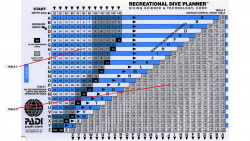
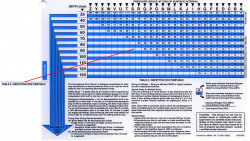
Use the planner to quickly look up a depth and/or time. Combine the use of two or more tables to calculate a depth or a limit. When using the planner there are a number of rules to follow. Follow these rules when calculating depth and time.
General Rules for the use of the Recreational Dive Planner:
- Bottom Time is the total time in minutes from the beginning of the descent to the beginning of the final ascent to the surface or safety stop.
- Any dive to 35 feet or less is calculated as a dive to 35 feet.
- Use the exact or next greater depth shown for depth
- Use the exact or next greater time shown for time
- Slowly ascend from all dives at a rate that does not exceed 30 feet per minute. Slower is better. Remember the acronym: S.A.F.E. Slow Ascent For Each Dive. Be a S.A.F.E. diver.
- Always dive conservatively. Avoid using the Maximum times and/or depth for each dive.
- When diving in cold water or stressful situation, plan the dive as though the depth is 10 feet deeper than the actual dive.
- For repetitive dives dive your deepest dive first and each subsequent dive shallower than the previous dive.
- Limit your Maximum dive depth to your training abilities. Inexperienced divers should limit their depths to 60 feet. More experienced divers up to 100 feet and those who are technical or have specific needs to no greater than 130 feet. No dive should exceed the recreational limit for depth and time.
- A safety stop at 15 feet is recommended.
- Half stops, this is a technique where you pause your ascent at a depth at 1/2 your maximum depth and 1/2 the depth of each stop depth. For example, if your deepest depth was 80 feet, you would pause your ascent at 40 feet (1/2 your maximum depth) for 1 minute before resuming the ascent to the next stop depth of 20 feet for 1 minute, (1/2 of your 40 foot stop depth) resuming your ascent to your 15 foot safety stop.
Section ONE
Table 1
When preparing for the first dive of the day, you will start from table 1. Table 1 informs you of a number of pieces of information. It will tell you the Maximum Bottom Time (No Decompression Limit, NDL) for the depth you plan to dive (See the red circled numbers and the black box circled in red) and the residual nitrogen (The Gold colored circles) the body has retained by the end of the dive..
If performing multiple dives in a day, you will revisit table 1 to determine your Adjusted No Decompression Limit. We will cover Adjusted No Decompression Limit in more detail later.
Planning your dive
In order for you to prepare a plan for a dive on a colorful reef teaming with life sitting on a sandy bottom at 57 feet, you will need to collect a few pieces of information. You ask, “First, What is the Maximum amount of time I can spend at 57 feet without going into decompression?” When looking for depth on the planner, if you do not find your exact depth, round up to the next deepest depth. Looking at the planner, above you find the next deepest depth to be 60 feet. Scanning down the column of times below 60 feet you come to a black box at the very bottom to find 55 minutes. You now know the maximum amount of time you may spend at 57 feet for your first dive to be 55 minutes. This will be your No Decompression Limit, NDL for the planned dive.
Your next step is to determine the amount of time you would like to spend at 57 that will not exceed 55 minutes. You decide on 38 minutes. If this will be the only dive performed, there will be no need to continue with the planner. Go and enjoy your dive.
If your plan has you conducting multiple dives in a day, continue by scanning down the same column under 60 feet and locate your bottom time of 38 minutes. What you find are boxes with 37 minutes followed by 39 minutes. When searching for time where you do not find your exact time listed, round up to the next higher time. 39 minutes will be the time used in this case.
Next step, on the line 39 minutes resides on, follow the line to the right until you find an Alpha character. You should have come to the alpha character P.
The Alpha designation represents a theoretical quantity of Nitrogen absorbed and stored in the body by the end of your dive. It represents the Residual Nitrogen that remains in the body. To simplify planning Residual Nitrogen is calculated as time.
Review
- Decide on your Planned dive depth. In this example you planned for 57 feet.
- Locate the Planned Depth on the Recreational Dive Table. It is the row to the right of Start located in the upper left corner of table 1. If the exact depth cannot be located, use the next deepest depth.
- Locate the Maximum allowable time found in the Black Box at the bottom of the column for the Depth found on the table.
- Decide on an Actual Bottom Time. The time spent on the dive will be known as your Actual Bottom Time, ABT. In this example you decided on 38 minutes.
- If performing just one dive you may put the RDP down. If performing multiple dives, continue with the RDP
- Locate the Actual Bottom Time, ABT by following the column below 60 feet down until you find the Planned dive time. If the exact dive time cannot be located, locate the next highest time on the table. Your Actual Bottom time according to the table will be 39 minutes.
- Locate the Pressure Group, PG at the end of the dive. Follow the line the dive time is located to the right or the left until you locate the Alpha character. Your Pressure Group will be used when you move to table 2.
Sample Scenarios
Perform the following practice scenarios, checking your answer for correctness before moving to the next scenario.
- You perform a planned dive to 63 feet. What will your Pressure Group be at the end of the 32 minute dive?
- Q
- O
- P
- N
Answer: c Pressure Group P
Since 63 feet cannot be found at the top of the table, you move to the next deeper depth, 70 feet. Following the 70 foot column down you search for 32 minutes. The exact time was not found so you use the next highest time, 33 minutes. Scanning to the right, remaining on the horizontal line 33 minutes is found, you find the Pressure Group P
2. Your planned dive to 44 feet for 54 minutes places you in which Pressure Group?
- Q
- P
- S
- R
Answer: d Pressure Group R
44 feet cannot be found at the top of the table, you move to the next deeper depth, 50 feet. Scanning down the 50 foot column you search for 54 minutes. The exact time was not found so you use the next highest time, 57 minutes. Scanning to the right, remaining on the horizontal line 57 minutes is found, you find the Pressure Group R
Section One
Table 2
When performing multiple dives in a day, you will spend time on the surface between dives. The time spent on the surface allows excess nitrogen accumulated from previous dives to escape. Table 2 allows you to calculate the amount of residual nitrogen remaining in the body after a specified period of time on the surface.
Due to the excess nitrogen expelled during the surface interval you move from one pressure group to a lesser pressure group, affording you time or credit of time on your upcoming dive. Table 2 will inform you of this new pressure group.
To continue to table 2, you must start at the pressure group assigned from the end of your last dive. Let us continue from the last scenario where your planned dive to 44 feet for 54 minutes placed you in pressure group R at the end of the dive.
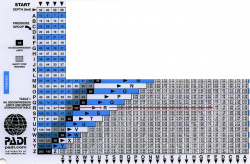
From the Pressure Group R continue on the horizontal line towards the right looking for a box containing a pair of numbers. The pair of numbers represent hours and minutes and denote time spent on the surface. After having spend 1 hour ans 10 minutes on the surface you find the pair of numbers where your 1:10 surface interval fall on or between the pair of numbers. You find the pair 1:08 and 1:15 which 1:10 falls between.
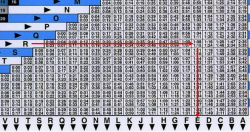
From the box containing the pair of times where your surface interval falls, follow the column down until you come to the new Pressure Group. In the example above, that new Pressure Group is E.
After spending 1 hour and 10 minutes on the surface you have released enough nitrogen to move to Pressure Group E from Pressure Group R. Knowing your new Pressure Group, you would move to table 3.
Sample Scenarios
Perform the following practice scenarios, checking your answer for correctness before moving to the next scenario.
- After a dive, table 1 shows your Pressure Group to be M. What will your pressure group be after a 56 minute surface interval?
- C
- D
- E
- B
Answer: b Pressure Group D
Scanning to the right of Pressure Group M, you look for the pair of times where your surface interval matches or is found between the two times. You find a pair with 0:56-1:04. Following the column down from this pair you come to the Pressure group designation D.
2. After a dive, table 1 shows your Pressure Group to be Q. What will your pressure group be after a 1 hour and 45 minute surface interval?
-
- D
- B
- C
- A
Answer: b Pressure Group B
Scanning to the right of Pressure Group Q, look for the pair of times where your surface interval matches or is found between the two times. You find a pair with 1:43 – 2:30. Follow the column down from this pair you come to the Pressure group designation B
Section ONE
Table 3
Table 3 informs you how much residual nitrogen remains in your body after spending a period of time out of the water in the form of minutes. This time is then added to the planned Actual Dive Time, ABT for the upcoming dive to determine your Pressure Group at the end of the dive. Table 3 also allows you to calculate your Adjusted No Decompression Limit, ANDL. Your Actual Bottom Time should not exceed the Adjusted No Decompression Limit.
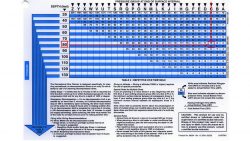
Let us continue from Table 2 where your new Pressure Group after spending a period time out of the water is a C. Moving to table 3 you would locate Pressure Group C at the top of the table. You would then locate the depth for your next and upcoming dive on the left side. If you do not find your exact depth listed, round up to the next deepest depth.. For example, a dive to 75 feet would have you use the 80 foot depth on the left side of the card.
From the depth on the left, follow the row to towards the right until you are lined up with the column underneath the pressure group, C. Where the row and the column intersect will be a pair of numbers.
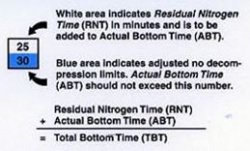
The legend above shows the meaning to the two numbers. The number surrounded by white is your Residual Nitrogen Time, RNT and it is this number you will add to your next dive time, your Actual Bottom Time, ABT that allows you to calculate your Pressure Group at the end of the next dive.
Remember your Total Bottom Time (the sum of the residual and the time spend on the dive) should not exceed the Adjusted No Decompression Limit, ANDL.
Using the two numbers where 80 foot row intersects with the pressure group C column, the 10 and the 20. It is the 10 that is added to the planned bottom time or the actual bottom time for the next dive.
You now know the Adjusted No Decompression limit for a dive to 75 feet is 20 minutes, the number surrounded by blue and the Residual Nitrogen Time is 10 minutes. The maximum amount of time you may spend at 75 feet, your Actual Bottom Time may not exceed 20 minutes, 30 minus 10 (The number surrounded by blue minus the number surrounded by white). Exceeding 20 minutes at depth on the dive would place you in decompression and that is what you must avoid.
You plan on an Actual Bottom Time of 15 minutes which will give you a Total Bottom Time, TBT of 25 minutes (15 ABT + 10 RNT= 25 TBT) at the end of the dive.
To find the Pressure Group you end your next dive at, move back to table 1.

Locate the depth of 75 feet and scan down the column until you find 25 minutes. If the exact depth and/or the time cannot be located on the RDP, round up.. 75 feet becomes 80 feet and 25 minutes remains 25 because 25 is found in the column underneath the 80 foot depth. Scan to the right or the left until you come to the Pressure Group designation. At the end of the 25 minute dive to 75 feet, you are in Pressure Group N.
Sample Scenarios
Perform the following practice scenarios, checking your answer for correctness before moving to the next scenario.
1. After a surface interval your pressure group is F. What is your RNT for a planned dive for 67 feet?
-
- 19
- 36
- 16
- 24
Answer: c. Your Residual Nitrogen Time is 16 minutes
Finding the pressure Group F at the top of table 3, next locate the depth for the planned and upcoming dive on the left side of table 3. 70 feet will need to be used because 67 feet is not listed. Following the row for 70 feet to where the pressure group F column intersect you find two numbers. The residual nitrogen time is the number 16 surrounded by white.
2. After a period of time on the surface you enter into pressure Group D. What is the Adjusted No Decompression Time for a dive to 55 feet?
-
- 61
- 16
- 13
- 39
Answer: d. Your Adjusted No Decompression limit is 39 minutes.
Finding the pressure Group D at the top of table 3, next locate the depth for the planned and upcoming dive on the left side of table 3. 50 feet will need to be used because 55 feet is not listed. Following the row for 60 feet to where the pressure group D column intersect you find two numbers. The Adjusted No Decompress Time is the number 39 surrounded by blue.
3. Following a surface interval you find yourself in pressure Group H. What is the Residual Nitrogen Time for a dive to 60 feet?
-
- 23
- 30
- 32
- 34
Answer: a. Your Residual Nitrogen Time is 23 minutes
Find pressure Group H at the top of table 3, next locate the depth for the planned and upcoming dive on the left side of table 3. Follow the row for 60 feet to where the pressure group H column intersect. The Adjusted No Decompress Time is the number 23 surrounded by white.
Answer the following questions:
- Residual Nitrogen Time is:
- The amount of nitrogen remaining on the body just after the dive.
- The amount of nitrogen remaining on the body just before a repetitive dive.
- Adjusted No Decompression Limit is:
- The depth limitation a diver has after spending a period of time on the surface
- The time limitation a diver can spend at a given depth after a period of time on the surface.
Answers: 1: b 2: b
Section ONE
The complete Dive Profile
Using the dive profile increases your chances for making sure you do not miss any steps in planning and executing your dives as well as show you pertinent information at a glance. It serves as a historical record of your dives profile and as a reference when planning future dives.
Fill out each field as data presents itself. Dive logs usually have just a portion of the table for each page a dive is logged. The table below is an example of one showing space for multiple dives along with an explanation of the fields.
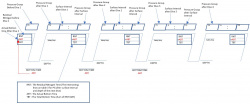
The table below shows an example with fields filled out after have performed three dives.

Section ONE
Repetitive Dives
he above table to walk through each dive, step by step will show how the values placed in each field were calculated. Have your RDP ready.
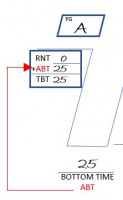
Starting at the left side, the Pressure Group Designation is assigned an A. It was assigned because there are no preceding dives that day. Typically the first dive of the day starts with a pressure group A. The box below the pressure group containing the RNT, ABT and the TBT the residual nitrogen time has a zero for the same reason there is an A for the pressure group. The actual bottom time is filled with 25 as noted by the Bottom time found at the bottom of the first dive. The total bottom time is simply ABT added to RNT
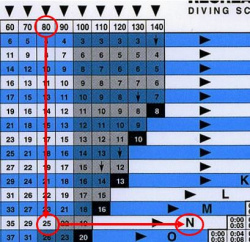
To determine the pressure group at the end of the dive, the total bottom time and the depth of the dive just completed are the two pieces of information needed. To locate the pressure group after the 25 minute dive to 75 feet, table 1 on the RDP needs to be consulted. Looking at table 1 of the RDP there is no 75 foot column. The rule states to round up to the next deepest depth. In this example that would be 80 feet. Scan down the 80 foot column until you come to 25 minutes then scan to the right along the same row 25 minutes is on to locate your pressure group. There you find N as the pressure group.
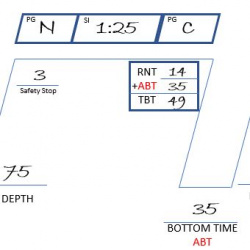
Fill in the Pressure Group after a 25 minutes dive to 75 in the space to the left of the surface interval as depicted in the image.
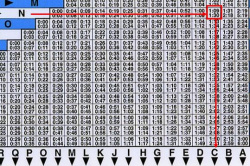
On the line for pressure group N, scan to the right looking for a pair of times that include the 1hr25min surface interval. From the time pair, scan down to find the new pressure group. Following a 1 hour and 25 minute surface interval, the pressure group went from an N to a C. You will be entering the water for your next dive, dive #2 in the example with a pressure group C.
Beginning the next dive in pressure group C implies there must be some residual nitrogen remaining in the body. The question is How Much? Residual nitrogen is provided as time. RNT is looked at in a few ways. 1) It is time which must be subtracted from the No Decompress Limit resulting with an Adjusted No Decompression Limit.
2) Residual Nitrogen Time, time that must be added to your Actual Bottom Time.
Let me elaborate the first example of what you just read, that RNT is time subtracted from the NDL. The subtraction of RNT from NDL results with the Adjusted No Decompression Limit, ANDL for the upcoming dive. Your Actual Bottom Time, ABT may not exceed your Adjusted No Decompression Limit, ANDL.
The second example RNT is added to your ABT. This becomes your Total Bottom Time, your TBT. This allows you to calculate the Pressure Group at then end of the dive. This example was just displayed above.
Moving to table 3 on the RDP, both of the above ways to calculate RNT and ANDL may be found.
Resuming with the table 3, let identify the Residual Nitrogen Time so the Total Bottom Time may be calculated as well as the Adjusted No Decompression Limit will be so the Actual Bottom Time does not exceed the ANDL.

The above Dive Profile shows a entering the second dive in Pressure Group C at a depth of 55 feet for 35 minutes of Actual Bottom Time. What is the RNT and the ANDL entering a dive in pressure group C to 55 feet?
From table 2 you determined the pressure group after a 1 hr and 25 min surface interval to be a C.

Flip the RDP to table 3, locate Pressure Group C on the top row and the 55 foot depth along the left side. Since 55 feet was not found, rounding up to the next deepest depth of 60 feet will be used. The RNT and ANDL times are located where the row for 60 feet and the column for pressure Group C intersect. There you find 14 and 41. The 14 represents the Residual Nitrogen Limit and the 41 minutes represents the Adjusted No Decompression Limit.
When planning on the dive time, remember the actual bottom time may not exceed the Adjusted No Decompression Limit.
Adding the 14 minutes RNT to the 35 minutes ABT results with 49 minutes of Total Bottom Time. The TBT is what’s used to calculate the Pressure Group at the end of the dive which is found on table 1.
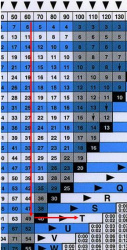
Returning to table 1, find the 60 foot depth, scan down the column until you find 49 minutes. From 49 minutes, scan to the right you locate the Pressure Group designation of T. After a 49 minute dive to 55 feet,the pressure group at the end of the second dive is T.
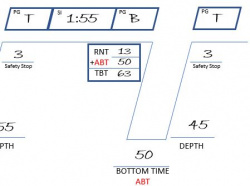
Time for you to walk through the steps that was necessary to fill in the Dive Plan seen on the left. Start at the end of dive 2, from pressure group T just before the 1 hr and 55 minute surface interval. Determine how pressure group B was calculated. Perform all the step necessary that walks you to pressure group T after the 50 minutes dive to 45 feet.
Section ONE
Special Considerations and rules for Repetitive Dive
Safety Stops: When ever a diver comes within 3 pressures groups of a No Decompression Limit or any dive greater than 100ft, a safety stop is required
Emergency Decompression: If a decompression limit is exceeded by no more than 5 minutes, an 8 minute decompression stop at 15 ft is mandatory. Upon surfacing, the diver must remain out of the water for no less than 6 hours prior to making a dive. If the no decompression limit is exceeded by more than 5 minutes, a stop at 15 ft for no less than 15 minutes is required. Upon surfacing the dive must remain out of the water for no less than 24 hours prior to making a dive.
Flying after diving recommendations
For dives within recreational diving limits •Single dives: A minimum pre-flight surface interval of no less than 12 hours is recommended •Repetitive dives and or multi-day dives: A minimum pre-flight surface interval of no less than 18 hours is recommended
For dives requiring decompression stops •A minimum pre-flight surface interval of no less than 18 hours is recommended
Diving at Altitude: Diving at an altitude greater than 1000ft requires use of special procedures
Special rules for Multiple dives: If you are planning on 3 or more dives in a day, beginning with the first dive, if your ending pressure group after any dive is W or X, the minimum surface interval is 1 hour. If your ending pressure group after any dive is Y or Z, the minimum surface interval between subsequent dives is 3 hours.
General Rules •Ascent from all dives at a rate no greater than 30ft per minute. •When planning dives in cold water or dives that could be strenuous, plan the dive 10ft deeper than actual. •Never exceed the limits of the planner and avoid meeting the limits for depth and time. •Do not dive beyond your training and experience
Sample Scenarios – Planning Multiple Repetitive Dives
Perform the following practice scenarios, checking your answer for correctness before moving to the next scenario.
Determine the final pressure group upon surfacing after the series of dives. Use a straight edge on the RDP to remain within your columns and rows. Utilize the Dive Plan Profile to note your discoveries that brought you to the final pressure group.
- First dive: 68 ft/32 mins. 1hr 10min surface interval. Second dive: 46 ft/ 43 mins.
- Pressure Group R
- Pressure Group S
- Pressure Group T
- Pressure Group U
Answer: c. Pressure Group T
After a 32 minute dive to 68 feet, you end your dive in pressure group P. Both the depth and the time needed to be rounded up to the next higher level, where 68 feet becomes 70 feet and 32 minutes become 33 minutes. The reason is the RDP does not display a depth of 68 feet as well as a time of 32 feet. The rules state if the exact value cannot be found, you must use the next higher value.
After spending 1 hour and 10 minutes on your surface interval, you end up in pressure group D. You determined this by scanning over to table 2 from the ending pressure group of T for a range of numbers that exactly match or include your surface interval time. You find the time range 1:07-1:13 which 1:10 fits between. Scanning down the column you come to pressure group D.
To find your residual nitrogen time and your adjusted no decompression limit for the second dive, consult table 3 on the RDP.
Locating the depth on the left for the second dive you find there is no 46 foot listed and will use the next higher depth of 50 feet. Scanning to the right, remaining on the same row as 50 feet, you come to a block where the 50 foot row intersects with pressure group D to find the pair of minutes 19 and 61. The 19 represents residual nitrogen time and 61 represents the adjusted no decompression limit expressed in minutes.
You next step is to calculate your total bottom time. The two pieces of information needed to get the TBT is the residual nitrogen time and your actual bottom time. Adding the two numbers together result with your Total Bottom Time. Add 19 to 43 for a total bottom time of 62 minutes. 62 minutes is your total bottom time, TBT.
Moving back to the RDP table 1, scan down the column for 50 feet for the 62 minute TBT, moving to the next deeper depth, using 63 minutes, scan to the right to find T as the pressure group at the end of your second dive.
2. First dive: 77 ft/27 mins. 1hr 40min surface interval. Second dive: 55 ft/ 40 mins
- Pressure Group T
- Pressure Group U
- Pressure Group V
- Pressure Group S
Answer: b. Pressure Group U
A 27 minute dive to 77 feet places you in pressure group P. After spending 1 hour and 40 minutes on the surface you are placed in pressure group B. The residual nitrogen for entering the water for a dive to 55 feet is 11 minutes. At the end of the second dive, your actual bottom time was 40 minutes. Add the residual time of 11 minutes to the actual 40 minute dive time and your total bottom time comes to 51 minutes.
Looking at table 1 scan down the column for 60 feet, in search of 51 minutes takes you to 52 minutes. Scan to the right of 52 minutes to find pressure group U.
Under General Rules:
Safety Stops: When ever a diver comes within 3 pressures groups of a No Decompression Limit or any dive greater than 100ft, a safety stop is required
Both of the dives times went into the grey area of your RDP, the above rule should have been performed. It is recommended to always perform a safety stop regardless of depth or time as an added precaution.
Section TWO
Identifying the minimum Surface Interval
At this point you learned how to calculate dives, flowing through the dive table. You identified starting and ending pressure groups, residual nitrogen time, adjusted no decompression limit and total bottom time. You repeated this process for each sequential dive performed on a given dive day.
Now you need to know the answer to the question “How much time must you spend on the surface to support a second dive to a depth for so many minutes”
In this section you plan on performing two dives in the morning. You know the two sites and their respective depths. You just need to figure out how much time you need to spend on the surface to support a decent dive time for the second dive. After all the photography opportunities at the second site are phenomenal.
You plan your first dive to 66 feet for 35 minutes. You would like to spend your second dive at 45 feet for 65 minutes. How much time must you spend on the surface to support the second dive?
The steps required to calculate minimum surface interval is pretty straight forward. This time you will start on table 1, then move to table 3 before moving to table 2. You know all the pieces of the equation except the time needed to spend on the surface. Table 2 provides your surface interval credit. It will tell you how much time you need to remain on the surface to support a dive so not to exceed the Adjusted No Decompression Limit.
Next move to table 3. You know you you want to perform a 65 minute dive to 45 feet. Locate the 50 foot depth. Scan across the row for 50 feet looking at the blue box for a time the is equal or greater than the time you wish to spend at depth. In this case, the box containing 67 lines up with pressure group B. The blue box is the Adjusted No Decompression Limit. Your Actual Bottom Time should not exceed this limit.

Flipping the card to table 2, scan up to the pair of times where pressure group Q (the pressure group at the end of dive 1) and pressure group B intersect. You find the time range 1:43-2:30. The minimum surface interval to support a second dive to 45 feet for 65 minutes is no less than 1hr and 43 minutes.

The minimum surface interval places you at the limit for the adjusted no decompression limit. The Residual Nitrogen time of 13 minutes added to the actual bottom time of 65 minutes is a 78 minutes of Total Bottom Time. The No decompression limit for 50 feet is 80 minutes.
This places you in pressure group X at the end of the second dive.
Safety Stops: When ever a diver comes within 3 pressures groups of a No Decompression Limit or any dive greater than 100ft, a safety stop is required
Since you do not plan on any additional dives for the day, this TBT is just barely under the NDL of 80 minutes for 50 feet. If your plan should change, where you will perform a third dive, you should consider modifying your Surface Interval and/or Actual Bottom time that will leave you with a greater difference between the TBT and the NDL.
Sample Scenarios – Identifying the minimum Surface Interval
Perform the following practice scenarios, checking your answer for correctness before moving to the next scenario.
Identify the minimum surface interval to support the dives in the following example scenario.
- First dive 67 feet for 34 minutes. Second dive to 52 feet for 41 minutes. What is the minimum surface interval?
-
- 1:12
- 1:21
- 1:20
- 1:43
Answer: b. 1:21
At the end of the first dive your pressure group is a Q. Your next dive is to 52 feet.
Looking at table 3, you use 60 feet. Scanning across the row 60 feet is on towards the right, looking for a time surrounded by blue, for the Adjusted No Decompression Limit of 41 or greater. 41 may be found under the pressure group C column.

To find the amount of time it takes you to go from a pressure group of Q to a pressure group of C, you need to consult table 2.
On table 2, locate the pressure group Q and scan to the right within the same row Q is on until you come to where pressure group C intersect with Q. There you find 1:21-1:42. 1:21 is the minimum amount of surface interval required to support the second dive to 52 feet for 41 minutes.

2. First dive 73 feet for 24 minutes. Second dive to 42 feet for 64 minutes. What is the minimum surface interval?
-
- 1:26
- 1:09
- 1:31
- 1:13
Answer: c. 1:31
At the end of dive you you entered into pressure group N. Your second dive is for 64 minutes. Using table 3, along the row for 50 feet,scan to the right until you find the Adjusted No Decompression Limit that is 64 or greater. You find that under the pressure group B column, where the column for pressure group B and and the 50 foot depth to the left intersect.

You now know you must get from pressure group N to pressure group B during the surface interval. on table 2, you locate where pressure group N and pressure group B intersect to find 1:31-2:18. 1:31 is the minimum surface time needed to support the second dive to 42 feet for 62 minutes.
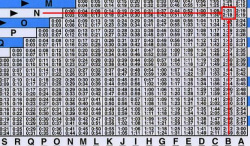
Please note that each of the examples are for exercise purposes only. You should not plan for dives that target the maximum no decompression times. Allow for times and/or depths that provide a greater deviation.
This concludes this article. I hope it has proven to be a valuable resource and your refer to it when needed as well as recommend it to others. I want to leave you with access to other articles on the RDP for reference.
Take some time to visit the links. There you can find more information that is tailored to be more specific.
More Recreation Dive Table Articles
One more side note before you go. Throughout the article, we reference time. Time at depth, surface interval time, no decompression time, etc.. The table you walked through was for dives using ‘air.’ When the time comes where you feel you need more time during the dive, or shorter surface intervals, you will be considering diving with Enriched Air. Air enriched with Oxygen. Commonly called Nitrox.
Here is an article that explain Nitrox. I urge you to read it before beginning a course. It will help you with terminology, concepts, tables, acronyms and more. You will go into the course a much stronger and knowledgeable person allowing you to absorb more than without the information provided in the article.
You may reference the article on Nitrox here.
Side Note:
The Navy tables were originally designed for single dives use by U.S. Navy divers. The divers using them were supervised by Navy Divemasters who managed the divers profiles and controlled their decompression, if any, by staging in-water decompression. Diving operations were supported by on-site recompression chambers and access to a diving medical officer. You can see the amount of resources employed to support a dive becomes impractical for recreational diving, hence the use of Navy dive tables for recreational is not recommended.
Dive organizations such as TDI, SSI, and NAUI sanction use of a rendition of Navy dive tables. These tables are used by sport divers to plan dives which are typically more technical in nature rather than recreational.
Because tables sanctioned by organizations typically do not favor recreational dive planning, you will not find articles specific on their use at divetalking.com for the use of planning recreational dives.
There are a few organizations whose dive tables are tailored towards recreational use. Two of these organizations are Diving Science and Technology sanctioned by PADI and IANTD where the former is more granular. The choice is yours.
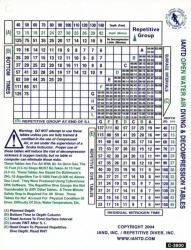

Dive Safe and remember, First in – Last out!

